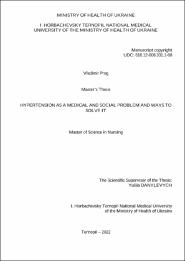| dc.description.abstract | Hypertension, or high blood pressure, is a serious pathological condition that significantly increases the risk of developing diseases of the cardiovascular system, brain, kidneys, and other diseases. Hypertension is also one of the leading causes of death worldwide. The role of a nurse in improving hypertension control has expanded over the past 50 years, complementing the role of a doctor. Today, the roles of practicing nurses in the management of hypertension include all aspects of treatment, including detection, referral to specialists, and follow-up; diagnosis and drug treatment; patient education, counseling, and skills development; care coordination; clinic or office management.
methods
With the help of this scientific study, the epidemiology, etiology and pathogenesis of arterial hypertension, the classification and clinic of arterial hypertension were studied, the features of the treatment of patients with arterial hypertension in certain clinical situations were investigated, urgent conditions against the background of a pronounced increase in blood pressure were investigated, and the features of medical rehabilitation, dispensary supervision, primary and secondary prevention of hypertension were studied.
Findings
Medical staff should remember that there is no need to quickly reduce blood pressure to "normal numbers" (especially in acute stroke). Stroke patients require a special approach, because excessive and/or rapid decrease in blood pressure can lead to an increase in cerebral ischemia. In most other cases, doctors are recommended to ensure a rapid, but no more than 25% of the initial values, reduction in blood pressure for the first 2 hours from the moment of admission to the hospital.
For all patients with hypertension, it is recommended to develop an individual rehabilitation plan, which includes recommendations for achieving the target BP, self-monitoring of BP, increasing adherence to treatment, nutrition, physical activity, weight control. In order to reduce the risk of cardiovascular complications, all patients with hypertension are recommended at least 150 minutes (2 hours 30 minutes) per week of moderate-intensity aerobic physical activity or 75 minutes (1 hour 15 minutes) per week of high-intensity aerobic physical activity.
Dynamic monitoring is an extremely important component of medical care for patients with hypertension, whose tasks are: maintaining target blood pressure levels, monitoring the implementation of medical recommendations for correcting risk factors, monitoring compliance with the antihypertensive therapy regimen, assessing the condition of target organs. | uk |

